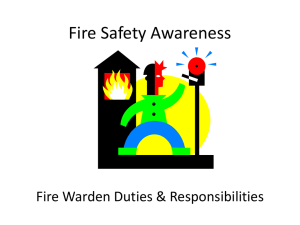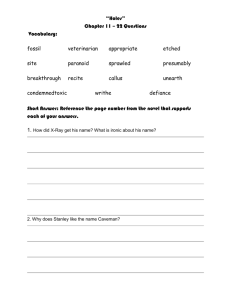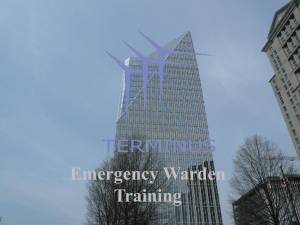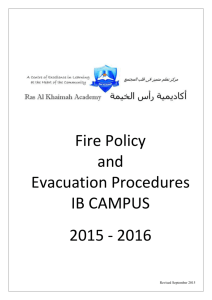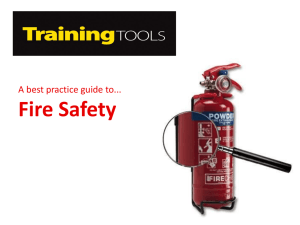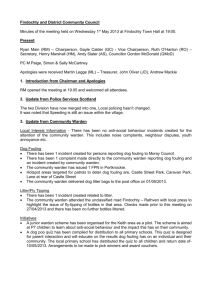Terms of Reference- January 2013
advertisement
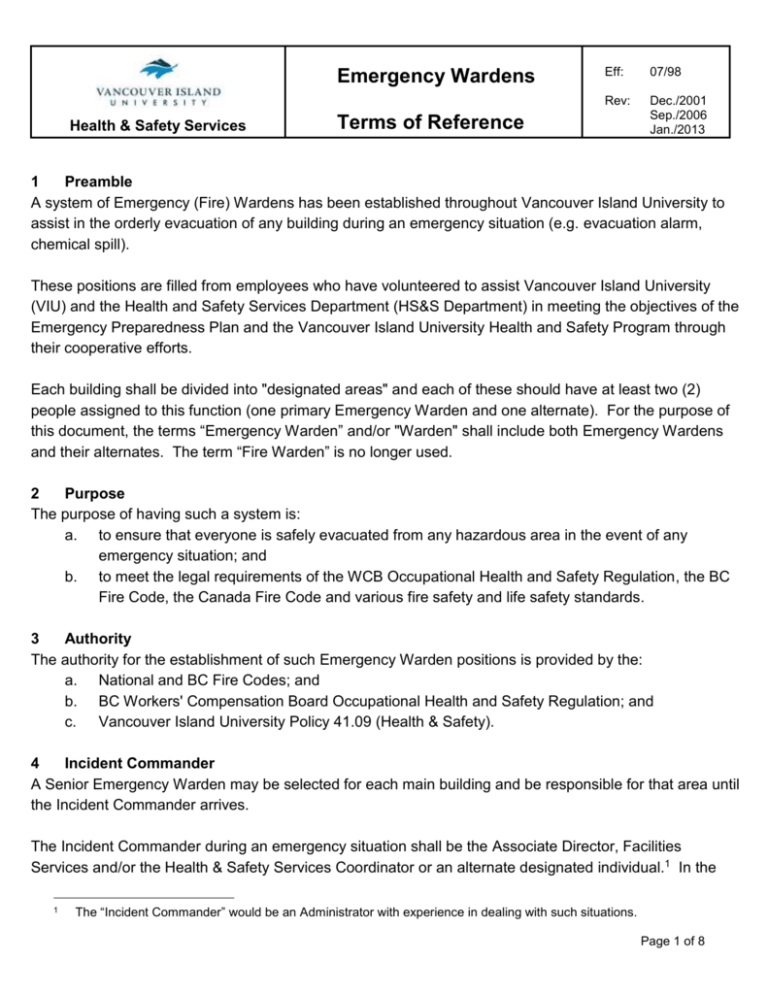
Emergency Wardens Health & Safety Services Eff: 07/98 Rev: Dec./2001 Sep./2006 Jan./2013 Terms of Reference 1 Preamble A system of Emergency (Fire) Wardens has been established throughout Vancouver Island University to assist in the orderly evacuation of any building during an emergency situation (e.g. evacuation alarm, chemical spill). These positions are filled from employees who have volunteered to assist Vancouver Island University (VIU) and the Health and Safety Services Department (HS&S Department) in meeting the objectives of the Emergency Preparedness Plan and the Vancouver Island University Health and Safety Program through their cooperative efforts. Each building shall be divided into "designated areas" and each of these should have at least two (2) people assigned to this function (one primary Emergency Warden and one alternate). For the purpose of this document, the terms “Emergency Warden” and/or "Warden" shall include both Emergency Wardens and their alternates. The term “Fire Warden” is no longer used. 2 Purpose The purpose of having such a system is: a. to ensure that everyone is safely evacuated from any hazardous area in the event of any emergency situation; and b. to meet the legal requirements of the WCB Occupational Health and Safety Regulation, the BC Fire Code, the Canada Fire Code and various fire safety and life safety standards. 3 Authority The authority for the establishment of such Emergency Warden positions is provided by the: a. National and BC Fire Codes; and b. BC Workers' Compensation Board Occupational Health and Safety Regulation; and c. Vancouver Island University Policy 41.09 (Health & Safety). 4 Incident Commander A Senior Emergency Warden may be selected for each main building and be responsible for that area until the Incident Commander arrives. The Incident Commander during an emergency situation shall be the Associate Director, Facilities Services and/or the Health & Safety Services Coordinator or an alternate designated individual.1 In the 1 The “Incident Commander” would be an Administrator with experience in dealing with such situations. Page 1 of 8 Emergency Wardens Health & Safety Services Terms of Reference Eff: 07/98 Rev: Dec./2001 Sep./2006 Jan./2013 case of satellite campuses, it shall be the senior administrative person on-site or a designated Emergency Warden. The Incident Commander will be responsible for: a. coordinating and directing all Vancouver Island University response personnel including, but not limited to the Emergency Wardens, First Aid, Security and Facilities Services personnel; and b. communicating with all outside emergency response personnel (e.g. police, fire, ambulance); and c. ensuring the safety of all VIU employees, students and other persons during any emergency situation; and d. communicating, as soon as possible, the nature of the situation to the Health and Safety Services Office and/or Director, Facilities Services and/or other VIU administrative staff as required. The Health and Safety Services Office is directly responsible for the development, maintenance and coordination of the Emergency Warden system throughout University as well as the overall Emergency Preparedness Program. 5 Communications Communication between the Incident Commander and other personnel during an emergency situation will be conducted verbally. 6 Identification of Emergency Wardens and Other Personnel Emergency Wardens and alternates shall be provided with either a high visibility vest or baseball cap along with a picture ID to assist in their identification during emergency situations.2 These vests or baseball caps shall be worn on the outside of all clothing, at all times when an emergency situation has been declared (e.g. by an alarm) to ensure that the Emergency Wardens can be easily identified by the Incident Commander and/or by other emergency response personnel (both internal and external). Other additional means of identification may also be provided (e.g. identification tags) and shall be worn during the emergency situation. 2 Previously issued high visibility vests may state “Fire Warden or Emergency Warden”. For the purposes of this document the terms “Emergency Warden” and “Fire Warden” are synonymous. Page 2 of 8 Emergency Wardens Health & Safety Services Terms of Reference Eff: 07/98 Rev: Dec./2001 Sep./2006 Jan./2013 7 Duties and Responsibilities Emergency Wardens have been assigned areas of responsibility by building and by floor. There may be more than one Emergency Warden and alternate responsible for any given floor within a building. Each designated area should have an Emergency Warden and an alternate to ensure adequate coverage. 7.1 In the Event of an Evacuation Alarm or Other Emergency Situation In the event of an evacuation alarm or other notification to evacuate, the Emergency Wardens will take charge of their area and ensure that an orderly evacuation has occurred. The following points are provided as guidance. 1. ALL PERSONS must leave the building when an alarm sounds or when instructed to do so.3 2. Instructors (faculty) are responsible for evacuating their respective classes and should lead them in an orderly manner to a pre-determined area (e.g. designated assembly point) that is well clear of the building involved. 3. Non-instructional supervisors are responsible for evacuating the staff in their respective area of operation. 4. Emergency Wardens are responsible for ensuring their area of responsibility has been properly evacuated, but not necessarily lead that evacuation, unless their other duties have been attended to. 5. Emergency Wardens will conduct a "sweep" (walk through) of their assigned area prior to exiting the building to ensure that: everyone has vacated the area; all doors are closed and windows (if applicable) are closed, provided this can be done safely and in a timely fashion (i.e. there is no risk of entrapment to the Emergency Warden); in laboratory areas, any "master" gas control valves (if applicable), which controls gas powered, bench mounted equipment within the room are to be shut off;4 any main electrical “kill switches” (if applicable) that control bench mounted electrical equipment within the room are to be shut off;5 3 If people refuse to leave the building when an alarm sound and/or when instructed to do so, note their location and names (if possible). DO NOT ARGUE with them. Report this information to the Incident Commander, and/or the Health and Safety, and/or the Executive Director, Facilities Services, or to the senior Fire Department Response member on site, as soon as possible. It is a serious offence not to evacuate an area when an alarm sounds and/or when instructed to do so. 4 Exterior gas control valves feeding buildings are NOT to be touched. Page 3 of 8 Emergency Wardens Health & Safety Services Terms of Reference Eff: 07/98 Rev: Dec./2001 Sep./2006 Jan./2013 6. 7. 8. lights shall be left ON, (to ensure that people leaving and/or emergency response personnel have clear visibility); Once the "sweep" of your assigned area is completed, report to your assigned area (e.g. nearest entrance / exit door) and await further instructions. Contact the Incident Commander and/or the Fire Department senior officer only in the event of an urgent situation (e.g. injured person) that requires immediate attention (as outlined below in Section 7.3), otherwise report to your assigned exit area / assembly area and await further instructions; An Emergency Warden or other responsible individual shall be assigned the duty of guarding the various entrance doors and ensuring that No Unauthorized Personnel 6 enter the building until the nature of the situation has been confirmed and the notification of an "ALL CLEAR" situation has been given by the Incident Commander or designate. UNDER NO CIRCUMSTANCES is any Emergency Warden and/or any other employee, not designated as an “authorized” emergency response person, to attempt to silence (shut off) any alarm bells or otherwise touch the main fire alarm panel. Only designated and qualified persons shall perform that activity. 7.2 Evacuation of People All persons (except Emergency Wardens) shall immediately leave a building in response to an alarm or other evacuation order. People must move well away from the building involved, preferably to the nearby assembly areas designated for their location. No one shall remain immediately adjacent to a building entrance/exit unless authorized to do so (e.g. Emergency Warden guarding doors). In the event an Emergency Warden encounters a person in a room, hallway or stairwell who is not authorized to be there, they shall direct that individual to leave the building at once. If they refuse, the previously stated procedure (see Footnote 6) should be followed. 5 Circuit breakers and/or electrical disconnect switches are NOT to be touched. Do NOT “unplug” electrical equipment. 6 The only personnel authorized to be in a building during an emergency are the following people: Incident Commander; Associate Director, Facilities Services and Campus Development; Health and Safety Services staff; internal Emergency Response Personnel (e.g. Facilities Services staff [when equipped with a two-way radio and wearing High Visibility vests], First Aid Attendants [if necessary]); external Emergency Response Personnel (e.g. police, fire, ambulance), Security staff (if applicable). Page 4 of 8 Emergency Wardens Health & Safety Services Terms of Reference Eff: 07/98 Rev: Dec./2001 Sep./2006 Jan./2013 7.2.1 Persons with Disabilities In the event a person with a disability is encountered above the ground floor level of any building, ensure that they are escorted to the nearest enclosed stair well (which does not contain smoke). Do not attempt to carry anyone out of the building. Enclosed stairwells may be considered as "refuge areas", or "fire safe areas" and people will be safe there until they can be evacuated by the Fire Department. These areas will be clearly labeled for buildings that have refuge areas. If possible, have one person stay with any person with a disability until assistance arrives. Inform the Emergency Warden and/or the Fire Department IMMEDIATELY of the exact whereabouts of any person requiring evacuation assistance. 250-740-6600 may be called for quicker response During evacuation drills or exercises, persons with disabilities can safely remain in the Areas of Refuge or near a stairwell until informed the exercise is over. Where persons with disabilities are encountered on the ground level floors, ensure that they are evacuated to a safe area which is well clear of the building. 7.2.2 Injured Persons In the event that an injured person is encountered, unless they are in imminent danger from the fire or other hazard, do not attempt to move them, but immediately notify the Emergency Warden and/or the Fire Department of the exact location of the injured person. If they are in danger from the fire, and can be moved safely, transfer them to the nearest fire safe stairwell (which does not contain smoke) until they can be evacuated by the Fire Department. If possible, have someone stay with them until assistance arrives. If a fire safe stairwell is not readily available, move them to the nearest room and close the door while help is obtained. DO NOT endanger yourself in an attempt to rescue someone else; rather get help from qualified emergency response personnel (i.e. Fire Department). Page 5 of 8 Emergency Wardens Health & Safety Services Eff: 07/98 Rev: Dec./2001 Sep./2006 Jan./2013 Terms of Reference 7.3 Limitations It is not the responsibility of any Emergency Warden to attempt to put out any fire or otherwise become involved in handling an emergency situation unless that individual has been adequately trained and designated as part of an identified VIU response team. 8 Emergency Drills It is the responsibility of the Health and Safety Services Office, in consultation with the Facilities Services Office to schedule routine drills, exercises and tests of the emergency preparedness system, including, but not limited to regular evacuation drills. These drills and exercises may be announced to building occupants in advance. ALL ALARMS OR NOTIFICATIONS TO EVACUATE AN AREA SHALL BE TREATED AS IF IT IS A REAL SITUATION and the building evacuated promptly. 9 Sounding Alarms in the Event of an Emergency All buildings are equipped with integrated emergency alarms that are connected to a centralized alarm monitoring station that will automatically summon the Fire Department as soon as the bell system begins to ring. If possible, whoever sounded the alarm should meet either the Emergency Warden, or Security, or the Fire Department at the main entrance to explain the nature of the emergency and its location. 9.1 Exceptions In the event of a fire in a building not connected to the centralized alarm monitoring system, in addition to activating one of the nearby pull stations to sound the alarm and evacuate the building, it may be necessary to place a telephone call direct to the Fire Department. This can be done by calling the VIU Emergency Number at 250-740-6600 and advising of the location of the fire and requesting the Fire Department respond immediately. Page 6 of 8 Emergency Wardens Health & Safety Services Eff: 07/98 Rev: Dec./2001 Sep./2006 Jan./2013 Terms of Reference 9.2 Alternate Signalling There may be situations when the sounding of the alarm bells may NOT be used to commence an evacuation (e.g. bomb threat, hazardous spill). In those cases the order to evacuate a specific area or building will be by word-of-mouth or other suitable means. 10 All Clear Notification Silencing (turning off) of the alarm bells SHALL NOT be considered as an indication of either an "all clear" situation and/or permission to re-enter the building(s). A verbal notification of an "all clear" situation shall be given to the Emergency Wardens only by the Fire Department or VIU designate. There will not be an audible, all clear signal (e.g. ringing of bells) given. If you are unsure whether it is safe to enter the building, DO NOT! Under no circumstances shall anyone attempt to silence an alarm bell without authorization from the Fire Department or designate. 11 Unforeseen Delays / Inclement Weather In the event of an evacuation from a building during adverse weather conditions, or if there appears that there will be an extended delay in people being allowed to return to the building, Emergency Wardens may direct the people to other buildings or areas of the campus where they can seek shelter. When doing this, ensure that: a. the alternate area is well away from the evacuated building or hazard; b. routes to these alternate areas take the people away from the evacuated building or hazard; c. people are moved in groups, in an orderly fashion so as not to interfere with any emergency response personnel; d. vehicles are NOT used to reach the alternate areas; e. people are NOT permitted to attempt to access any vehicle in a parking area within the evacuated area immediately adjacent to any building; f. people are not “released” from campus until instructed to do so. 12 Media Presence In the event that the media responds to an emergency situation, they should be referred to either the Incident Commander, or to the University Relations Office. If media become aggressive and do not wish Page 7 of 8 Emergency Wardens Health & Safety Services Eff: 07/98 Rev: Dec./2001 Sep./2006 Jan./2013 Terms of Reference to contact the University Relations Office, refer them to the Fire Department commander, or the police officer in charge. In the event of a protracted emergency situation, specific Vancouver Island University staff will be assigned the responsibility of dealing with the media. 13 Training Periodic training will be provided to Emergency Wardens to ensure that they are kept current on the operations of the emergency preparedness system and associated activities. It is expected the Emergency Wardens (including alternates) will make all reasonable attempts to attend these training sessions. This training will include, but not be limited to: a. Regular refresher training; b. Response protocols for other emergency types (e.g. bomb threats, earthquake). 14 Adequate Coverage by Emergency Wardens If the designated Emergency Warden will be away from their assigned area for a long period of time, please ensure that you advise your alternate and/or the Emergency Warden nearest your area to ensure adequate coverage should that be necessary. If you cannot continue being an Emergency Warden, please ensure that you find a replacement and advise the Health and Safety Services Office of the individuals name so that the new person can be adequately trained. 15 Other Points of Clarification Emergency Wardens: a. will not be issued master keys for their inspectional areas; b. will not be responsible for testing fire alarms; c. will not be responsible for testing fire extinguishers or other fire safety equipment. Page 8 of 8
